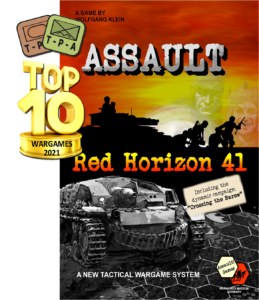Assault – Red Horizon 41

Game Description
Assault – Red Horizon 41 is the first volume in a planned series of tactical level wargames in which players lead historical units into battle during Operation Barbarossa (June through October 1941). A Clash of Titans – the German Army and the Soviet Army fighting one another in a life and death struggle with infantry, artillery and armored units.
Assault – Red Horizon 41 is intentionally not intended to be a simulation, but rather it abstracts certain aspects in favor of playability and manageable game length to convey the feeling of comprehensive tactical combat situations.
Game Mechanics and rules:
Assault – Red Horizon 41 is a turn-based, semi-historical system with a modular ruleset. A Turn consists of 5 different Phases:
- Initiative,
- Planning,
- Support,
- Action,
- and Organization (Cleanup).
Players use Command points to activate units in order to achieve the goals and victory conditions. Combat is resolved using six-sided customized symbolic dice in conjunction with cards.
Overall, the Assault game system is modular: the rule-set contains basic-, unit-specific-, and optional rules to help beginners delve into the game and in the various maps can be assembled as desired to form new scenarios.
What makes the game different from the competition:
The Assault Game System is designed to be completely modular and to accommodate a wide range of preferences for those playing it. There are different scenarios that the players can choose from, and within these scenarios, the Order of Battle can vary through the use of Formation Cards. In each scenario, rather than being given a set Order of Battle, the players will randomly select Formation Cards (infantry, artillery, or armor/vehicle) based on the side they are playing.

The Formation Cards give the player a certain number and type of units available for the scenario. This ensures both variation and regular surprises, since the make-up of your forces will change from game to game. Your High Command has assigned you certain units to achieve a particular goal; you will have to adjust your individual tactics based on the available units and the objectives you have been given!
Units in the Assault Game System are activated by Command points. Players receive a certain number of Command points, which are listed on the Formation cards. Before Command Phase, players secretly decide (behind a small screen or divider) which units to activate in the current turn. The Command point allowance lets the player activate approximately 75% of all available units. Thus, players must set priorities for the turn. Not only does this speed up the game play, since all units are not used in each turn, but it also makes for some exciting moments in the fight.
In the Assault Game System, we have tried to minimize the counter stacking issue. With many game systems in the hobby, you can find towers of counters and markers on certain hexes of the game board. The overview is then quickly lost. In the Assault Game System, there is a clear limit of one unit counter per hex, with the exception being when units in are being transported. In addition, there is usually only one command and/or status marker.
Regarding Command and Unit State Markers, we have devised a simple double-marker system: each marker is double-sided and after the end of the round, in the Organization Phase, the markers are simply flipped or removed depending on their color. This helps to speed up play.
In general, Assault has attempted to emphasize game flow. The fact that Command Points are assigned to activate units in the Planning Phase accelerates the game. Since the units to be activated are already established before the Action Phase, there is less for the player to think about and fewer opportunities for AP to set in.
Conclusion:
In summary, the Assault Game System is designed to be modular and can be expanded as desired. With a single map scenario, a game can be finished in as little as 1 to 2 hours. If you have more time available, you could take an entire day for a battle, creating larger maps with multiple tiles. Players should be able to learn the game relatively quickly. We are planning future expansions, but the base game will remain the same. We are not going to be flooding you with new rules that make our earlier games redundant and leave players confused and out of pocket.[:]